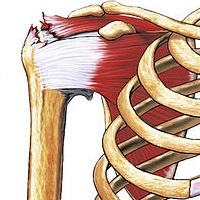
Photo from wikipedia
BACKGROUND There have been conflicting results when comparing outcomes of open vs. arthroscopic anterosuperior rotator cuff repairs with subscapularis involvement. The purpose of this study was to evaluate midterm outcome… Click to show full abstract
BACKGROUND There have been conflicting results when comparing outcomes of open vs. arthroscopic anterosuperior rotator cuff repairs with subscapularis involvement. The purpose of this study was to evaluate midterm outcome differences and complications following open vs. arthroscopic repair of rotator cuff tears involving the subscapularis by a single surgeon. METHODS This was a retrospective review of 57 rotator cuff repairs involving the subscapularis performed by a single surgeon over a 10-year period. During this time, the surgeon transitioned from open to arthroscopic repair. Preoperative and postoperative range of motion, lift-off test, belly press test, and American Shoulder and Elbow Surgeons (ASES) Standardized Shoulder Assessment form scores were measured. RESULTS Eighteen patients had open procedures and 39 had arthroscopic repair. The mean preoperative ASES score for the open group was 39 and postoperatively was 79. The mean preoperative ASES score for the arthroscopic group was 44 and improved to 80 postoperatively. There was no significant difference in score or change in score between the 2 groups (P > .05). There was only 1 complication. It occurred in the open group and was a superficial wound dehiscence. CONCLUSIONS This study demonstrated no outcome differences between open and arthroscopic rotator cuff repair involving the subscapularis, even with large subscapularis tears. Both techniques significantly improved shoulder function. Arthroscopic and open rotator cuff repairs including the subscapularis are relatively safe procedures, and either technique is an acceptable option.
Journal Title: Journal of shoulder and elbow surgery
Year Published: 2019
Link to full text (if available)
Share on Social Media: Sign Up to like & get
recommendations!